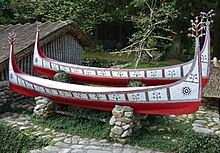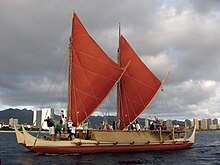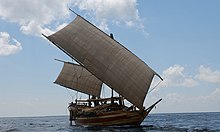Лодка с аутригером

Лодки с выносными опорами представляют собой различные водные суда , оснащенные одним или несколькими поплавками боковой поддержки, известными как выносные опоры , которые крепятся к одной или обеим сторонам основного корпуса . Они могут варьироваться от небольших долбленых каноэ до больших дощатых судов. Лодки с выносными опорами также могут различаться по своей конфигурации: от исконных конфигураций с двойным корпусом ( катамараны ) до судов с одной выносной опорой, распространенных на островах Тихого океана и Мадагаскаре , до судов с двумя выносными опорами ( тримараны ), распространенных на островах Юго-Восточной Азии . Традиционно они оснащаются австронезийскими парусами, такими как паруса «крабовые клешни» и паруса «таня» , но в наше время часто оснащаются бензиновыми двигателями.

В отличие от судна с одним корпусом, судно с выносными опорами или с двойным корпусом обеспечивает устойчивость за счет расстояния между корпусами, а не за счет формы каждого отдельного корпуса. Таким образом, корпуса лодок с выносными опорами или двухкорпусных лодок обычно длиннее, уже и более гидродинамически эффективны, чем у однокорпусных судов. По сравнению с другими типами каноэ, каноэ меньшего размера с выносными опорами могут быть довольно быстрыми, но при этом на них можно грести и плавать в более бурной воде. Однако эта техника гребли сильно отличается от гребли на байдарках или гребле . Лопасть , или лопасть, используемая гребцом, односторонняя, с прямым или двойным изгибом стержнем.

Эти суда были первыми настоящими океанскими кораблями и являются важной частью австронезийского наследия. Это были суда, которые позволили австронезийской экспансии с Тайваня на острова Индийского и Тихого океана примерно с 3000 г. до н. э. Они составляют основную часть традиционных лодок на островах Юго-Восточной Азии , на острове Меланезия , в Микронезии , Полинезии и на Мадагаскаре . Они распространились на другие культуры, с которыми австронезийцы вступали в контакт, особенно в Шри-Ланке и южной Индии , а также на побережье Восточной Африки . В наше время суда с выносными опорами используются в парусном спорте . Конфигурации катамаранов и тримаранов также широко используются для высокоскоростных судов .
История
[ редактировать ]
Лодки с выносными опорами изначально были разработаны австронезийскоязычными народами островов Юго-Восточной Азии для морских путешествий. Считается, что использование аутригеров могло быть изначально вызвано необходимостью обеспечения устойчивости небольших судов после изобретения парусов с крабовыми клешнями где-то около 1500 г. до н.э. [1]
Лодки с выносными опорами были необходимы для перевозки австронезийцев как на восток в Полинезию и Новую Зеландию , так и на запад через Индийский океан до Мадагаскара в период миграции австронезийцев . Австронезийские народы ( малагасы , морские жители Юго-Восточной Азии , микронезийцы , меланезийцы , коренные народы Тайваня и полинезийцы ) продолжают оставаться основными пользователями лодок с выносными опорами.

The simplest form of all ancestral Austronesian boats had five parts. The bottom part consists of single piece of hollowed-out log. At the sides were two planks, and two horseshoe-shaped wood pieces formed the prow and stern. These were "sewn" together with dowels and lashings. They had no central rudders but were instead steered using an oar on one side. The ancestral rig was the mastless triangular crab claw sail which had two booms that could be tilted to the wind. These were built in the double-canoe configuration or had a single outrigger on the windward side. In Island Southeast Asia, these developed into double outriggers on each side that provided greater stability. The triangular crab claw sails also later developed into square or rectangular tanja sails, which like crab claw sails, had booms spanning the upper and lower edges. Fixed masts also developed later in both Southeast Asia (usually as bipod or tripod masts) and Oceania.[2]
Early researchers like Heine-Geldern (1932) and Hornell (1943) once believed that catamarans evolved from outrigger boats, but modern authors specializing in Austronesian cultures like Doran (1981) and Mahdi (1988) now believe it to be the opposite.[3][4][5]
Two canoes bound together developed directly from minimal raft technologies of two logs tied together. Over time, the double-hulled canoe form developed into the asymmetric double canoe, where one hull is smaller than the other. Eventually the smaller hull became the prototype outrigger, giving way to the single outrigger canoe, which diverged into the reversible single outrigger canoe in Oceania. Finally, the single outrigger types developed into the double outrigger canoe (or trimarans).[3][4][5]

This would also explain why older Austronesian populations in Island Southeast Asia tend to favor double outrigger boats, as it keeps the boats stable when tacking. But they still have small regions where catamarans and single-outrigger boats are still used. In contrast, more distant outlying descendant populations in Micronesia, Polynesia, Madagascar, and the Comoros retained the double-hull and the single outrigger boat types, for the technology of double outriggers never reached them (exceptions being western Melanesia). To deal with the problem of the instability of the boat when the outrigger faces leeward when tacking, they instead developed the shunting technique in sailing, in conjunction with reversible single-outriggers.[3][4][5][6][7]

When Magellan's ships first encountered the Chamorros of the Mariana Islands in 1521, Antonio Pigafetta recorded that the Chamorros' sailboats far surpassed Magellan's in speed and maneuverability. Similarly, the Spanish priest Francisco Combés, describing the large karakoa outrigger warships of the Visayan Islands in the Philippines, remarked:[9]
"That care and attention, which govern their boat-building, cause their ships to sail like birds, while ours are like lead in this regard."
— Francisco Combés, Historia de las islas de Mindanao, Iolo y sus adyacentes (1667)
Outrigger fishing canoes are also used among certain non-Austronesian groups, such as the Sinhalese in Sri Lanka, where they are known as oruwa,[10] as well as among some groups in the Andaman and Nicobar Islands.[11] They can also be found in East Africa (e.g., the ungalawa of Tanzania).
The acquisition of the catamaran and outrigger boat technology by the non-Austronesian peoples in Sri Lanka and southern India is the result of very early Austronesian contact with the region, including the Maldives and Laccadive Islands. This is estimated to have occurred around 1000 to 600 BCE and onwards. This may have possibly included limited colonization that have since been assimilated. This is still evident in Sri Lankan and South Indian languages. For example, Tamil paṭavu, Telugu paḍava, and Kannada paḍahu, all meaning "ship", are all derived from Proto-Hesperonesian *padaw, "sailboat", with Austronesian cognates like Javanese perahu, Kadazan padau, Maranao padaw, Cebuano paráw, Samoan folau, Hawaiian halau, and Māori wharau.[3]

The technology has persisted into the modern age. Outrigger boats can be quite large fishing or transport vessels. In the Philippines, outrigger boats (called bangka or paraw) are often fitted with petrol engines. The links between seafaring and outrigger boats in the Philippines extend through to political life, in which the smallest political unit in the country is still called "barangay" after the historical balangay outrigger boats used in the original migrations of the first Austronesian peoples across the archipelago and beyond. The Polynesian Voyaging Society has two double-hull sailing catamarans, Hokulea and Hawaiiloa, and sails them between various islands in the Pacific using traditional Polynesian navigation methods without instruments. The Hikianalia and Alingano Maisu are other extant double-hulled voyaging canoes.
Terminology and linguistics
[edit]The German linguist Otto Dempwolff (1934-1938) originally reconstructed the Proto-Austronesian word for "boat" as *waŋkaŋ, and included the reflexes for both *baŋkaʔ and *waŋkaʔ as its descendants.[12] However modern linguists like Robert Blust generally reject this.[13][14] Mahdi (2016) instead reconstructs four words for "boat" in the Austronesian languages, all ultimately derived from the monosyllabic protoforms *Cu and *baŋ. They are:[15][16]
- a) *qaCu - cognates include Squliq-Atayal qasuʔ, Pazeh ʔasuʔ, and Bunun hatoʔ
- b) *qabaŋ - cognates include Kanakanavu abaŋɯ, Oponohu-Rukai havaŋu, Siraya avang, Gaddang ʔabaŋ, Tiruray ʔawaŋ, Iranun awaŋ, Mentawai abak, and Moken kabaŋ
- c) *baŋkaʔ - cognates include Kavalan baŋka, Tagalog baŋkaʔ, Tausug baŋkaʔ, Mori and Muna baŋka, and Sumbawa baŋka
- d) *waŋkaʔ' - cognates include Manggarai and Rembong waŋka, Tobati wăgě, Yabem waŋ, Suau waga, Fijian waqa, Tongan vaka, and Hawaiian waʻa; Tahitian and Samoan vaʻa
Instead of being cognates, the protoforms *baŋkaʔ and *waŋkaʔ are believed to be doublets. The protoforms *qabaŋ and *baŋkaʔ are composites with a common precursor, with the *qa- and -*ka positioned differently. Only *qaCu and *qabaŋ can be traced back to Proto-Austronesian, with the rest being later developments.[15]
The outrigger float is called the ama in many Polynesian languages (compare Hawaiian ama, Māori ama, and Samoan ama, all meaning 'outrigger float'), realisations of Proto-Malayo-Polynesian *saRman 'outrigger float'.[17][18] Similar terms also exist in other Malayo-Polynesian languages, such as Pohnpeian dahm, Yapese thaam, Ambonese Malay semang, all meaning 'outrigger float', as well as Chamorro sakman meaning '[a] large canoe.'[18] The outrigger boom—spars connecting the ama to the main hull (or the two hulls in a double-hull canoe)—are called ʻiako in Hawaiian and kiato in Māori (with similar words in other Polynesian languages), ultimately from Proto-Oceanic *kiajo or its doublet *kayajo both meaning 'outrigger boom' (compare Loniu kiec, Kiribati kiaro, and Tongan kiato, as well as Seimat ayas and Gedaged ayad, all meaning 'outrigger boom').[19][20] In Philippine languages, the outrigger floats are called katig or kate, from Proto-Philippine *katiR.[21][22]
Types
[edit]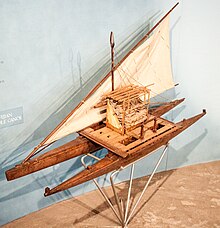
Double-outrigger boats are more prevalent in Southeast Asia, though single-outriggers and catamarans also exist. They have two outrigger floats connected to spars lashed across a single hull. They range in size from small vessels like the jukung, vinta, and the paraw; to medium-sized trading and fishing vessels like the balangay and basnigan; to very large warships like the karakoa and kora kora. In Philippine vessels, additional booms called batangan are usually added across the outrigger spars (tadik), in between the outrigger floats (katig) and the main hull (bangka).[22][23] In modern terminology, especially in leisure or sport boating, double-outrigger ships are usually termed trimaran or triple-hull ships.
An unusual type of double-outrigger boat design, preserved in scale models in the Pitt Rivers Museum, forms a triangle shape. The front ends of the outriggers are attached directly to the hull, while the rear ends are splayed out. These boats were small and used exclusively as passenger ferries in the Pasig River of the Philippines.[24]
Catamarans and single-outrigger canoes are the traditional configurations in Polynesia, Micronesia, and Madagascar. In the Pacific Islands, a single outrigger float is called an ama. It is connected to the main hull by spars called ʻiako (Hawaiian), ʻiato (Tahitian), or kiato (Māori). The ama, which is usually rigged on the left side, provides stability. The paddlers need to be careful to avoid leaning too far on the opposite side of the ama, as that may cause the canoe to capsize (huli or lumaʻi). Double-outrigger configurations, a later innovation from Southeast Asian Austronesians, never reached Oceania.
Single-outrigger dugout canoes also survived until recent times in some parts of the Philippines. Examples include a specimen in the University of Southampton from Manila Bay collected in the 1940s, as well as boats from Lake Bulusan and Lake Buhi of the Bicol Region of southern Luzon from as recently as 2015. The single outrigger is used to provide lateral stability, while still allowing fishermen to work with fishing nets. These boats were paddled and were not equipped with sails. They have largely disappeared in modern times, partly due to the scarcity of suitable timber and partly due to the relative cheapness of fiberglass boats.[24]
List of traditional outrigger vessels by region
[edit]The following is an incomplete list of traditional Austronesian outrigger vessels. It also includes catamarans.
Island Southeast Asia
[edit]Indonesia
[edit]
Malaysia
[edit]Philippines
[edit]

Island Melanesia
[edit]

Fiji
[edit]Papua New Guinea
[edit]Solomon Islands
[edit]Vanuatu
[edit]Micronesia
[edit]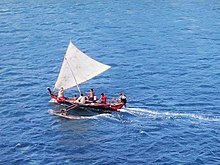
Caroline Islands
[edit]Kiribati
[edit]Marshall Islands
[edit]Mariana Islands, incl. Guam
[edit]Palau
[edit]Yap
[edit]Polynesia
[edit]
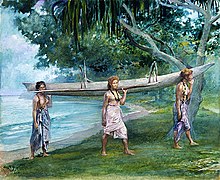
Cook Islands
[edit]Hawaiʻi
[edit]Marquesas
[edit]New Zealand
[edit]Samoa
[edit]Society Islands
[edit]Tonga
[edit]Tuvalu
[edit]Madagascar
[edit]
Non-Austronesian outrigger boats
[edit]The following are traditional outrigger boats acquired by other cultures from contact with Austronesian sailors.
Sri Lanka
[edit]East Africa
[edit]Modern sport
[edit]Outrigger canoe racing has become a popular canoeing sport, with numerous clubs located around the world. Outrigger Canoe Racing is the State sport of Hawaii and an interscholastic high school sport. In Hawaii, entire families participate in summer regattas with age groups from keiki (children as young as 6 with an adult steersperson) and age 12 through age 60+.
Major races in Hawaii include the Molokaʻi Hoe 43 mi (69 km) men's race from the island of Molokai to Oahu across the Kaiwi Channel, Na Wahine O Ke Kai (same race for women) and the Queen Liliʻuokalani Race held near Kona on the Island of Hawai.

In modern sport outrigger canoeing, ships are classified according to the configuration and number of the hulls and the number of paddlers, including the OC1, OC2, OC3, OC4 and OC6 (with the respective number of paddlers using a single-hull outrigger canoe), and the DC12 or OC12 (with twelve paddlers using a double-hull outrigger canoe, two six-person canoes rigged together like a catamaran). Outriggers without a rudder are referred to as V1, V2, etc. (where V refers to vaʻa).
Six-person outrigger canoes (or OC6) are among the most commonly used for sport use; single-person outrigger canoes (or OC1) are also very common. Two and four-person outrigger canoes are also sometimes used, and two six-person outrigger canoes are sometimes rigged together like a catamaran to form a twelve-person double canoe.
Modern OC6 hulls and amas are commonly made from glass-reinforced plastic. However, some canoes are made of more traditional materials. In Ancient Hawaii, canoes were carved from the trunks of very old koa trees. These canoes, although rare, are still very much in use today. The ʻiako are usually made of wood; the ʻiako-ama and ʻiako-hull connections are typically done with rope wrapped and tied in an interlocking fashion to reduce the risk of the connection coming completely apart if the rope breaks.
Modern OC1 hulls and amas are commonly made from glass-reinforced plastic, carbon fiber reinforced plastic, and/or Kevlar to produce a strong but light canoe. OC1 are often made with rudders operated by foot pedals. More traditional designs do not have rudders. OC1 commonly use ʻiako made of aluminium or carbon fiber, with a mechanism for quickly assembling and disassembling the canoe (snap buttons, large wing nuts, etc.).
Roles
[edit]In an outrigger canoe, the paddlers sit in line, facing toward the bow of the canoe (i.e., forward, in the direction of travel, unlike rowing). The seats are numbered from 1 (closest to the bow) to the number of seats in the canoe, usually 6. The steerer (or steersman or steersperson) sits in the last seat of the canoe (seat 6 in the common OC6) and, as the name indicates, is primarily responsible for steering. The paddler sitting in seat 1 is called the stroke (or stroker) and is responsible for setting the pace of the paddle strokes. The stroker should have a high level of endurance to keep the rate (the number of strokes taken in a given amount of time) manageable for whatever the situation may be. The first two positions may also be involved in certain steering manoeuvers. This usually involves the draw stroke. During a tight turn, the one seat might poke to make the canoe turn the opposite way. In the middle of the canoe (seats number 3 and 4) known as the powerhouse are the strong and powerful paddlers. Any of the 2 can be the 'caller' who directs when to switch over their blades, when to pick up or slow down the stroking pace, etc. Whoever is caller must have very good leadership skills and know how to think off the top of their heads in any situation. Every position has an important role to play in the canoe.
In an OC1, the single paddler must also steer the canoe. Some OC1s have rudders operated by foot pedals, while OC1s without rudders must be steered by drawing and paddling as needed for steering purposes while paddling to move the canoe forward.
Steersman
[edit]
A good steersman is able to maintain the straight attitude of the canoe throughout the course of a race, and also keep the boat and the crew safe in rough sea conditions. They may also take advantage of water conditions to gain extra speed by surfing. The steersman uses a single bladed steering paddle which has a larger blade than a standard outrigger paddle, is built stronger, and has less or no bend in its shaft. They steer by the following methods:
- Poking: holding the paddle vertically against the side of the canoe, causing drag on that side to cause the canoe to turn that direction. (left to go left and right to go right)
- Drawing: paddling at a 45 to 90-degree angle to pull water under the canoe, causing the canoe to turn the opposite direction.
- Posting: holding the paddle in the water out to the side with the forward edge angled opposite to the desired turn direction, usually as a prelude to drawing.
- Paddling: by applying power on one side of the canoe, the steersman can influence to a small degree which way the canoe will turn. Paddling also increases the total power moving the canoe forward compared to the other steering methods. The steersman should try and paddle as much as possible so he or she doesn't slow down the canoe by contributing to the amount of weight in the canoe.
A steersman also skippers the canoe and instructs all other paddlers as necessary. As an outrigger canoe is a long narrow canoe with the steersman placed at the very end, the steersman must give instructions sufficiently loudly and clearly for the entire crew to hear. From a water safety perspective the steersman should also be among the most experienced crew members, and be knowledgeable with the waterways and weather conditions, relevant maritime rules and other safety considerations such as the use of personal flotation devices, rigging of the canoe, placement of paddlers in the various seating positions, and recovery from a huli by righting the canoe and bailing out the water. The steersman should also be able to keep the ama down during rough water.
Paddlers
[edit]
Paddlers use single-bladed paddles, usually with single or double bent shafts. The paddling stroke is similar to that of most other racing canoe paddling strokes, involving primarily core and lat strength. Generally, each paddler paddles on the opposite side from the paddler in directly front (for example, in an OC6, paddlers in seats 1, 3, and 5 paddle on one side, while paddlers in seats 2 and 4 paddle on the other side). All paddlers switch sides simultaneously on a call from one who is the designated caller. The steerer may paddle either side or switch sides as needed for steering purposes. The steersman will also switch sides to keep the ama from popping up and capsizing the canoe.
Stronger paddlers are typically placed in the middle of the canoe, while paddlers with the most endurance tend to be placed at the front, as the lead paddler sets the pace for the crew. All other paddlers synchronize their strokes to the paddler in front of them (whom they can directly see).
In rough water, it is often desirable to have a paddler with steering skill in seat 5 (of an OC6), to allow for the steerer to have that paddler also take steering strokes if needed in some situations. In conditions when the boat is surfing, the stern of the canoe will be so far out of the water that seat 5 will have to keep the boat on course. A seat 5 paddler with steering skill can also assist in preventing a huli by staying on the ama side during a particularly rough stretch of water.
In water rough enough to splash into the canoe, paddlers also need to pay attention to the water level in the canoe, report the situation to the steerer, and bail out the water as necessary. Paddlers also need to know how to recover from a huli under the steerer's direction.
In a quick turn situation, paddlers at the front may also be instructed to une (poke steer, causes the canoe to turn the opposite direction) or kahi (post and draw steer, pulls the canoe to the side where this is done) to help bring the canoe around a turn quickly.
Racing
[edit]
The length of a race ranges from short sprints (e.g., 250–500 metres for the OC1 and the OC12, 500–2000 metres (usually includes turns) for the OC6) to longer events, including marathons (e.g., 42 kilometres). A number of races are raced over distances that far exceed 42 kilometres, including the Molokaʻi Hoe that crosses the Kaiwi Channel between the islands of Molokai and Oahu in Hawaii. However, long-distance races of 20 to 30 kilometres are more common, with shorter 5 to 8 kilometre courses typically being offered to novice paddlers and those under 20 years of age.
Longer races involving the OC6 often involve paddler replacements, which involve exit and entry to the canoe directly from the water while the canoe is underway (this is called a water change). Typically, nine paddlers form a crew, with six paddling the OC6 and the other three resting, drinking, and/or eating on an escort boat. Replacement typically occurs at 20 to 30 minute intervals; the escort boat drops the relief paddlers into the water ahead of the OC6, which is steered toward them. The relief paddlers climb in on the ama side as those they are replacing roll out into the water on the opposite side. The escort boat then picks up the paddlers in the water so that they can rest, drink, and/or eat before they, in turn, relieve some of the paddlers in the OC6.

The longer races are typically conducted in the open ocean, e.g., between islands in the South Pacific. The Molokaʻi Hoe in Hawaii, The Hamilton Cup in Australia,[26] The Vaka Eiva in Rarotonga (Cook Islands),[27] The Motu2Motu in Aitutaki (Cook Islands)[28] and the Catalina Channel crossing in California[29] are four examples of races involving water changes.
Paddlers and crews are usually classified by gender and age. Gender classification is typically straightforward, with male, female, and coed classifications, with the latter being a crew with equal numbers of male and female paddlers (different rules may apply to nine-person coed crews doing a race with paddler replacements). Age classifications typically include youth divisions like 19-and-under, 16-and-under, etc., master divisions with minimum ages typically starting at 35 or 40 years of age, and an open division which allows paddlers of any age. A novice division for paddlers with less than a specified number of years of race experience (usually one or two) may also exist in a given association.
In some races, a particular type of outrigger canoe, usually a more traditional design for the region, may be given its own racing classification. For example, races in Hawaii have a koa division, while southern California has a Bradley OC6 division and northern California OC1 sprint races have a traditional (no rudder) division.
Organisations
[edit]The International Va'a Federation (IVF) oversees va'a racing worldwide, including the IVF World Championships [30] and at the Pacific Games.[31]
Outrigger racing organizations in the United States include the East Coast Outrigger Racing Association (ECORA), the Hawaiian Canoe Racing Association (HCRA), the Northern California Outrigger Canoe Association (NCOCA), the Southern California Outrigger Canoe Association (SCORA), and several more.
See also
[edit]- Ama and Aka
- Austronesian maritime trade network
- Burulan
- Canoe sailing
- Catamaran
- Crab claw sail
- Daramba
- Hiri trade cycle
- Kula ring
- Lapita culture
- Lashed-lug boat
- Maritime Silk Road
- Marshall Islands stick chart
- Multihull
- Polynesian multihull terminology
- Polynesian navigation
- Proa
- Sa Huynh-Kalanay Interaction Sphere
- Tanja sail
- Trimaran
- Weriyeng
References
[edit]- ^ Campbell, I.C. (1995). "The Lateen Sail in World History". Journal of World History. 6 (1): 1–23. JSTOR 20078617.
- ^ Adrian, Horridge (2008). "Origins and Relationships of Pacific Canoes and Rigs". In Di Piazza, Anne; Pearthree, Erik (eds.). Canoes of the Grand Ocean (PDF). BAR International Series 1802. Archaeopress. ISBN 9781407302898.
- ^ Jump up to: a b c d Mahdi, Waruno (1999). "The Dispersal of Austronesian boat forms in the Indian Ocean". In Blench, Roger; Spriggs, Matthew (eds.). Archaeology and Language III: Artefacts languages, and texts. One World Archaeology. Vol. 34. Routledge. pp. 144–179. ISBN 0415100542.
- ^ Jump up to: a b c Doran, Edwin B. (1981). Wangka: Austronesian Canoe Origins. Texas A&M University Press. ISBN 9780890961070.
- ^ Jump up to: a b c Doran, Edwin Jr. (1974). "Outrigger Ages". The Journal of the Polynesian Society. 83 (2): 130–140.
- ^ Beheim, B. A.; Bell, A. V. (23 February 2011). "Inheritance, ecology and the evolution of the canoes of east Oceania". Proceedings of the Royal Society B: Biological Sciences. 278 (1721): 3089–3095. doi:10.1098/rspb.2011.0060. PMC 3158936. PMID 21345865.
- ^ Hornell, James (1932). "Was the Double-Outrigger Known in Polynesia and Micronesia? A Critical Study". The Journal of the Polynesian Society. 41 (2 (162)): 131–143.
- ^ Francisco Ignacio Alcina (1668). Historia de las islas e indios de Bisayas.
- ^ Francisco Combés (1667). Historia de las islas de Mindanao, Iolo y sus adyacentes : progressos de la religion y armas Catolicas.
- ^ Kapitän, Gerhard (May 1989). "Records of Native Craft in Sri Lanka—I: The single outrigger fishing canoe oruwa—Part 2.2: Rowed, paddled and poled oru". International Journal of Nautical Archaeology. 18 (2): 137–149. doi:10.1111/j.1095-9270.1989.tb00185.x.
- ^ Irenäus Eibl-Eibesfeldt, Land of a Thousand Atolls: A Study of Marine Life in the Maldive and Nicobar Islands, World Publishing Co., Cleveland and New York, 1964.
- ^ Dempwolff, Otto (1934–1938). "Vergleichende Lautlehre des austronesischen Wortschatzes". Zeitschrift für Eingeborenen-Sprachen (Special Publication nos. 15, 17, 19).
- ^ Blust, Robert; Trussel, Stephen. "The Austronesian Comparative Dictionary (Web Edition)". Retrieved 21 October 2019.
- ^ Jett, Stephen C. (2017). Ancient Ocean Crossings: Reconsidering the Case for Contacts with the Pre-Columbian Americas. University of Alabama Press. pp. 197–200. ISBN 9780817319397.
- ^ Jump up to: a b Mahdi, Waruno (2016). "Origins of Southeast Asian Shipping and Maritime Communication across the Indian Ocean". In Campbell, Gwyn (ed.). Early Exchange between Africa and the Wider Indian Ocean World. Palgrave Series in Indian Ocean World Studies. Palgrave Macmillan. pp. 25–49. ISBN 9783319338224.
- ^ Waruno, Mahdi (2017). "Pre-Austronesian origins of seafaring in Insular Southeast Asia". In Acri, Andrea; Blench, Roger; Landmann, Alexandra (eds.). Spirits and Ships: Cultural Transfers in Early Monsoon Asia. ISEAS Publishing. pp. 325–374. ISBN 9789814762755.
- ^ Blust, Robert; Trussel, Stephen (December 2013). "The Austronesian Comparative Dictionary". Oceanic Linguistics. 52 (2): 493–523. doi:10.1353/ol.2013.0016. S2CID 146739541.
- ^ Jump up to: a b Blust, Robert; Trussel, Stephen (14 January 2018). "*saRman outrigger float". Austronesian Comparative Dictionary. Retrieved 14 January 2018.
- ^ Blust, Robert; Trussel, Stephen (14 January 2018). "*kiajo outrigger boom". Austronesian Comparative Dictionary. Retrieved 14 January 2018.
- ^ Blust, Robert; Trussel, Stephen (14 January 2018). "*kayajo outrigger boom". Austronesian Comparative Dictionary. Retrieved 14 January 2018.
- ^ Lawrence A. Reid (1994). "Unravelling the linguistic histories of Philippine Negritos". In Tom Dutton & Darrell T. Tryon (ed.). Language Contact and Change in the Austronesian World. Trends in Linguistics, Studies and Monographs 77. Mouton de Gruyter. p. 456. ISBN 9783110127867.
- ^ Jump up to: a b Patricia Calzo Vega (1 June 2011). "The World of Amaya: Unleashing the Karakoa". GMA News Online. Retrieved 4 May 2018.
- ^ Emma Helen Blair & James Alexander Robertson, ed. (1906). The Philippine Islands, 1493-1898.
- ^ Jump up to: а б Стед, Мартин Родерик (2018). Определение конструктивных характеристик лодок коренных народов Филиппин: влияние технических изменений до и после колонизации (PDF) (MPhil). Университет Саутгемптона.
- ^ Jump up to: а б Ту, Карен Кан-Лун (2017). Ва и Татала: трансформация каноэ коренных народов на Япе и острове Орхидей (PDF) (доктор философии).
- ^ «Битва весла – события на острове Гамильтон» . www.hamiltonisland.com.au .
- ^ «Вака Эйва – Дом» . vakaeiva.com .
- ^ «Остров 2: Остров оффлайн» . Фейсбук .
- ^ «SCORA – Каталина Кроссинг – Чемпионат США по аутригерам» . hcatalinacrossing.org . Архивировано из оригинала 30 июля 2015 года.
- ^ «Об ЭКО» . Международная федерация Ваа . Архивировано из оригинала 25 июля 2016 года . Проверено 26 июля 2019 г.
- ^ «Техническое руководство по спорту Va'a, версия 2.0» (PDF) . Самоа 2019 . п. 6. Архивировано из оригинала (PDF) 9 июля 2019 года . Проверено 9 июля 2019 г.
Дальнейшее чтение
[ редактировать ]- Диркинг, Гэри (15 августа 2007 г.). Строительство парусных каноэ с выносными опорами: современные методы строительства трех быстрых и красивых лодок (мягкая обложка) (1-е изд.). Камден, Мэн: International Marine/Ragged Mountain Press/McGraw Hill. п. 192. ИСБН 0071487913 .
- Стив Уэст (2012) Гребля на каноэ с выносными опорами - Древний спорт королей - Путеводитель для гребцов , Batini Books, Kanucultural . ISBN 978-0-9586554-2-2
- Стив Уэст (2014) Гребля на каноэ на выносных опорах – искусство и навыки управления , Batini Books, Kanucultural . ISBN 0-9586554-1-3
- Стив Уэст (2014) Гребля на каноэ с выносными опорами – OC1, Руководство для гребцов , Batini Books, Kanucultural . ISBN 978-09574664-4-9
- Стив Уэст (2014) Гребля на каноэ с выносными опорами - V1, Руководство для гребцов , Книга Батини, Канукультура . ISBN 978-0-9574664-3-2
Внешние ссылки
[ редактировать ]- Диркинг, Гэри. «Ваапа: парусное каноэ с тремя досками» . Гэри Диркинг Судостроитель . Проверено 7 января 2015 г.
- Полинезийское общество путешествий
- Оригинальное каноэ с выносными опорами (Друа) в музее Фиджи
- Оригинальное каноэ с выносными опорами в Национальном морском музее Корнуолла
